The Canadian economy has returned to (or is forecast to) exceed the pre-pandemic levels of major economic indicators by the end of 2021. Nevertheless, Canada’s unemployment rate is forecast to remain above pre-pandemic levels throughout Quarter 3 of 2021. Similarly, economic indicators for BC have returned to or exceeded levels from before the pandemic. As of the end of Q3, more than 80.0% of the 12+ population eligible for their COVID-19 vaccine have received two doses.
BC remained in Step 3 of its Restart Plan and has decided to postpone moving to Step 4 for the foreseeable future. As mentioned in previous posts, Canada and BC has been offering financial support to aid people and businesses recover from the uncertain economic environment. This article gives readers an update from Q2 2021 to Q3 2021 of selected economic indicators. The indicators discussed herein are both indicative and representative of the Canadian, BC, and regional economies.
Labour Market
The labour force refers to the supply (employees) and demand (employers) for labour. The number of labour force participants and the unemployment rate are indicators that highlight the material changes that took place in the labour market from Q2 2021 to Q3 2021.
The federal government has initiated several programs to support employers and employees impacted by COVID-19. On July 30th, 2021, the Canada Recovery Benefit (CRB),the Canada Emergency Wage Subsidy (CEWS), and the Canada Recovery Sickness Benefit (CRSB) were extended from their initial expiry of September 25, 2021, until October 23, 2021. Furthermore, the Federal Government increased the maximum number of weeks available for the CRB, to a total of 54 weeks.
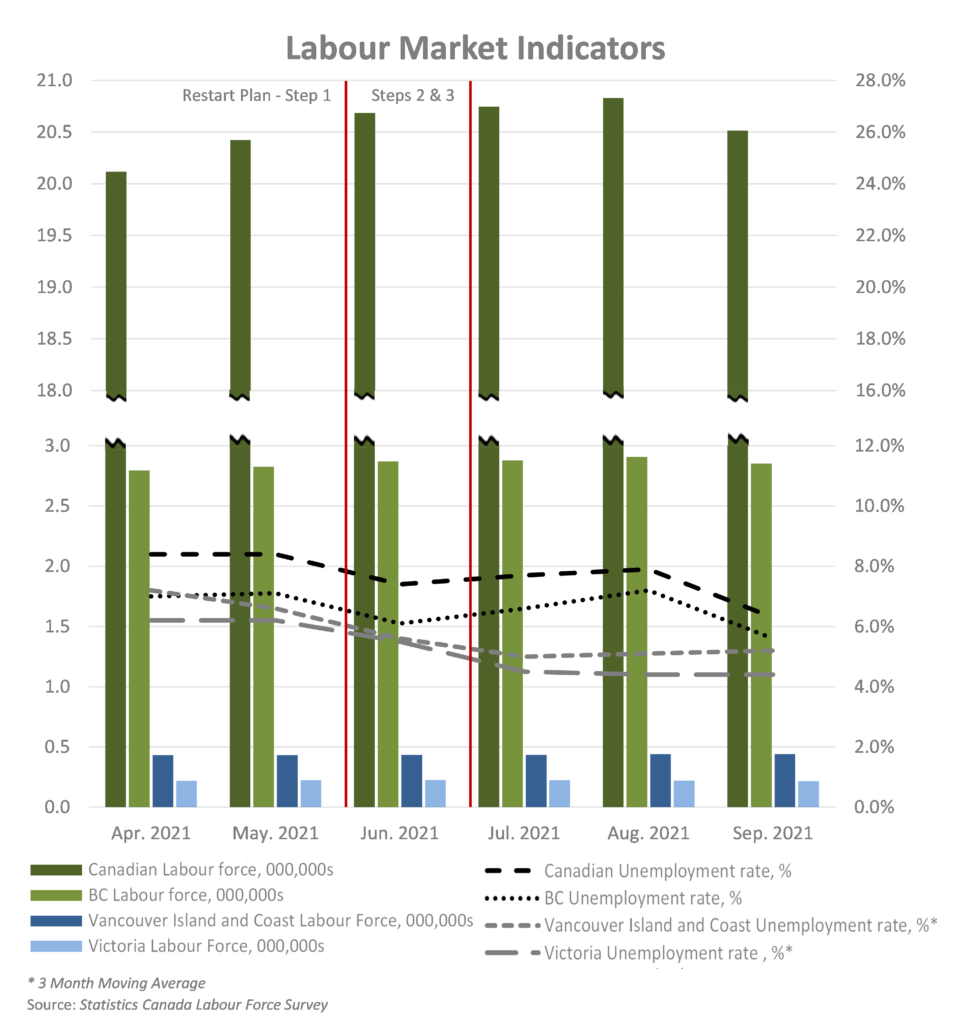
Before the impact of COVID-19, Canada was experiencing a steady increase in labour force participants. As of September 30, 2021, the Canadian labour force consisted of 20.5 million people, a decrease of approximately 170,000 participants since the prior quarter. At the beginning of Q3, the national unemployment rate was 7.4% which then decreased to 6.3% by the end of the quarter; but still 0.4% higher than the pre-pandemic rate of 5.9%. It is expected that this downward trend will continue for the near-term, especially given the success of the nation’s immunization program whereby 80% of the 12+ Canadian population has received two doses.
BC’s unemployment rates reflected the national trend for Q3, decreasing from 6.1% to 5.6% during the period. The quarter low was 0.6% higher than the province’s February 2020 rate of 5.0%. Notably, during Q3, BC was the only province in Canada where the number of labour force participants exceeded pre-pandemic levels and also reported the highest job vacancy rates in the country. The unemployment rate for Vancouver Island and Coastal regions also decreased, from 5.6% to 5.2%. In Victoria, the unemployment rate decreased throughout the quarter from 5.5% to 4.4%, which was still 0.9% higher than the pre-pandemic rate of 3.5%
During the three months ended September 30, 2021, BC’s Immunization Plan progressed into Phase 4, its final phase. At the end of Q3, 88.0% of those eligible for the COVID-19 vaccine in BC had received their first dose, and 81.0% had received their second dose.
Gross Domestic Product (GDP)
TD Economics (TDE) re-forecasts Canada’s real GDP year-over-year growth rate to 4.9%, which was lower than their Q2 forecast of 6.1% growth, due mainly to an overall decrease in expectations of global GDP growth as a result of supply chain distribution issues and the anticipated impact of the fourth wave COVID-19.
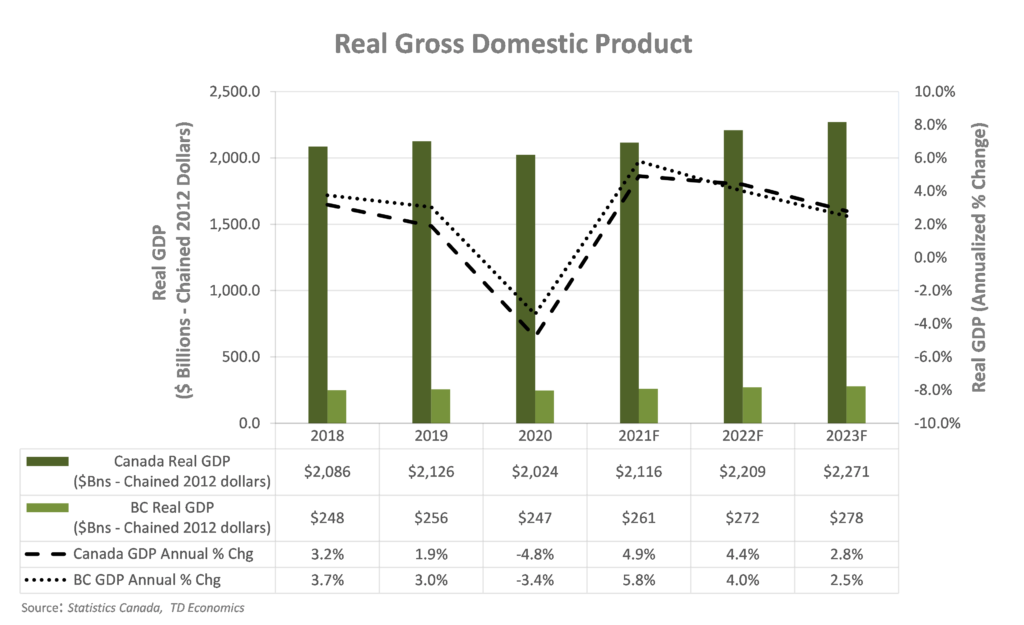
TDE also forecast slower growth for the BC economy to a real GDP increase of 5.8% for 2021, which is 0.9% lower than the 6.7% predicted last quarter. In dollar terms, our provincial GDP is forecast to increase to $259.8 billion, $1.5 billion lower than was forecast in the prior quarter. Despite the majority of the population being vaccinated in BC, the new highly transmissible COVID-19 Delta variant introduced a fourth wave of cases, with nearly 40% of the cases in the province as having the variant. The number of daily cases increased to over 700 in BC by the end of Q3.
Housing Market
Housing starts and average residential prices reflect market indicators with strong correlation to both the construction and real estate industries. BC’s housing starts dropped by 16.0% from 2019 to 2020. The BC Real Estate Association (BCREA) forecasts an increase of 18.5% in housing starts from 2020 to 2021 followed by a decrease of 12.8% from 2021 to 2022.
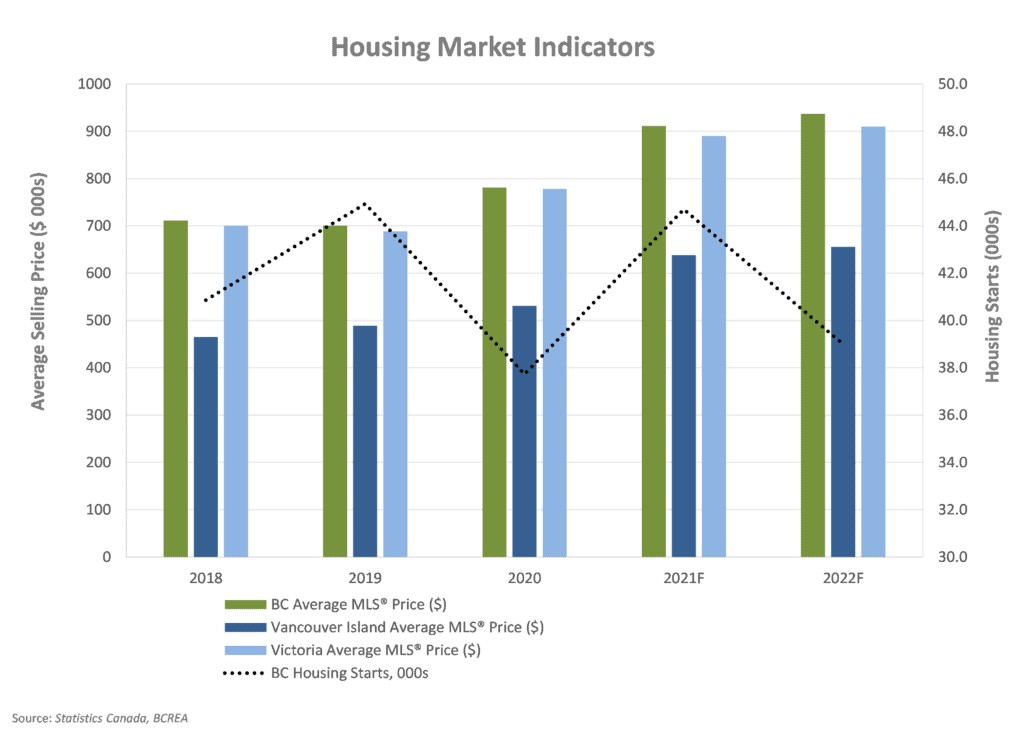
Last quarter, BC saw substantial increases in the average residential price despite the COVID-19 induced recession. During Q3, BC average prices continued to increase, with some areas having year-over-year price increases of up to 22.0%. BCREA forecast an increase of 16.6% in the average MLS® price for single family dwellings for 2021 to an average price of $911,300 and 2.9% for 2022 to an average price of $937,300. BC ranked among the most expensive housing markets in Canada as demand continues to widely surpass supply in the province (link 6). BCREA forecast increases in the average MLS® prices for single family dwellings for Victoria of 14.4% and 2.3% for 2021 and 2022, respectively.
Interest Rates & Foreign Exchange
The Bank of Canada (BoC) is expected to maintain the overnight target rate at its lower limit of 0.25% until its inflation objective is sustainably achieved. The last time the target rate was this low was in 2009 following the financial crisis. Nevertheless, TDE forecasts increases in the target rate for 2022 and 2023.
The low overnight target rate has led to a significant decrease in the prime rate, so Canadian business owners can obtain lower cost financing and consider refinancing existing debt at lower rates. As a result of the series of rate cuts, the average prime rate was 2.45% for Q3. The prime rate was forecast to remain at this level into the beginning of 2022 when it is likely to increase in step with the target overnight rate.

The Bank of Canada expected inflation to be higher than its target of 2.00% for the first half of 2022 but expected it to ease back towards 2.00% during the second half of the year. TDE forecasts inflation higher than its target for both 2021 and 2022, where TDE forecasts inflation to be 3.10% and 2.90%, respectively. For 2023, TDE predicted that inflation will decrease to 2.20%, approaching the federal benchmark of 2.00%.
The Q3 forecast for the average annual USD to CAD exchange rate for 2021 and 2022 remains unchanged from prior quarter to be $0.81 and $0.80 USD/CAD, respectively of $0.80 USD/CAD. The forecast for 2022 is a slight decrease to $0.81 USD/CAD.
Crude Oil Prices
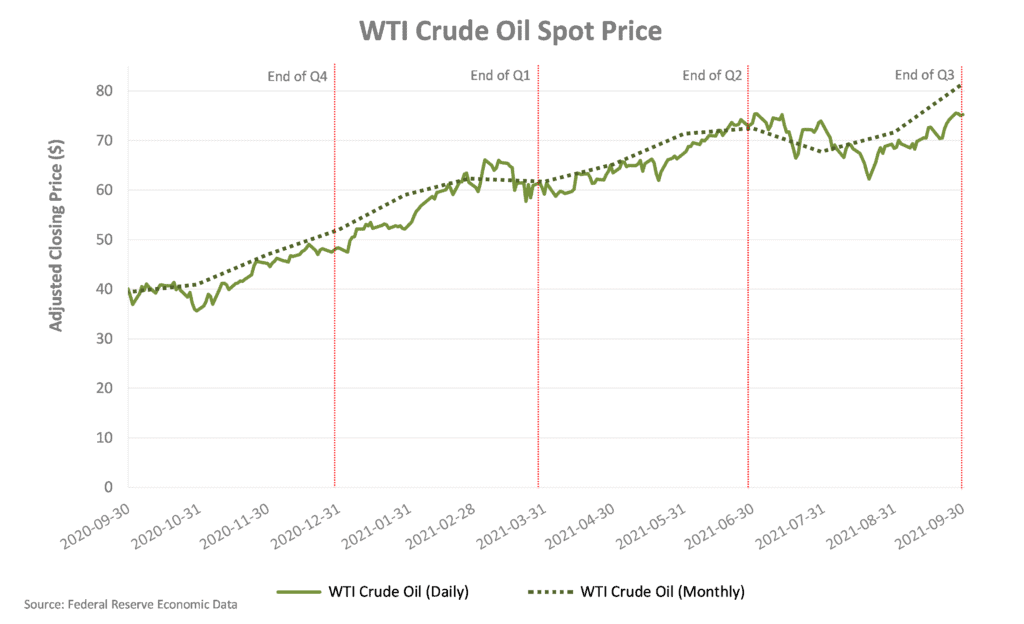
Canada has the 4th largest proven oil reserves in the world. As a net oil exporter, the Canadian economy is heavily impacted by the price of crude oil, with the greatest impact felt in Canada’s major oil producing provinces. The majority of Canadian crude oil production is in Alberta (81.0%), Saskatchewan (10.0%), and Newfoundland and Labrador (6.0%).
In North America, the West Texas Intermediate (WTI) crude oil spot price is the benchmark oil price. Historical WTI crude oil daily spot prices at the end of Q3 were:

Over the course of Q3, WTI oil prices ranged from $62.25 on August 20, 2021 to $75.54 on September 27, 2021, which is greater than both the 10-year and 20-year averages. The International Energy Agency (IEA) forecast global oil demand to return to their pre-pandemic levels by the end of 2022.
Capital Markets
The international response to COVID-19 at the beginning of March 2020 negatively impacted the current and anticipated operations of many privately-owned and publicly traded North American businesses. For publicly traded companies, this impact is evident in changes in capital markets during the period. On March 12, 2020 both the Dow Jones Industrial Average (DJIA) and S&P/TSX Composite Index witnessed the greatest single-day percentage drop since the stock market crashes of 1943 and 1987, respectively. By the start of 2021 both indices had recovered to their pre-COVID-19 levels, and as of September 30, 2021, the year-to-date percentage gain for the Dow Jones Industrial Average (DJIA) and S&P/TSX Composite index were 12.0% and 13.5%, respectively. Both indices reached record all-time highs in Q3.
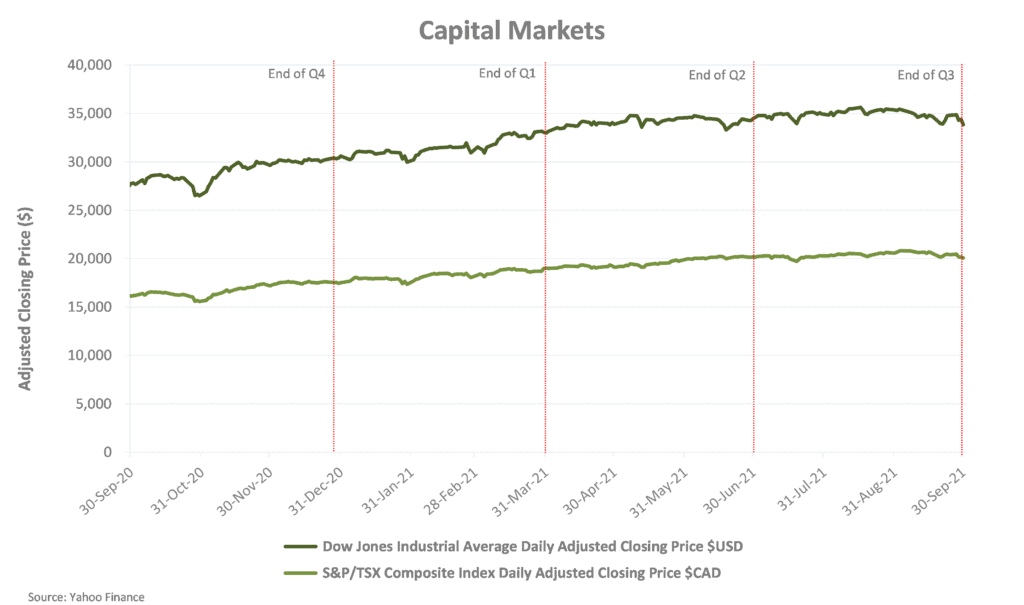
Although capital markets have fully recovered, it is important to note these indicators are based on forward looking assumptions and analysis, which have largely optimistic. As covered in the other sections of this post, overall, global and Canadian economies are still struggling to overcome the impact of COVID-19.
Moving into fourth quarter of 2021, BC expected to offer immunization booster shots to all eligible population by May of 2022 (link f). As of September 30, 2021, 88.0% of BC population eligible had received their first dose COVID-19 vaccination, and 81.0% had received their second dose (Link e). Nevertheless, it will be difficult to gauge the full impact of COVID-19 on the Canadian, BC, and regional economies until the world has recovered from the pandemic. The metrics analysed indicate an optimistic outcome, with the current economic forecast indicating near recovery by the end of 2021. Business owners will benefit from the fiscal stimulus provided by our governments and refinancing their existing debts with the historically low interest rates.
A glossary of all defined terms can be found here.
[1] In 1977, the TSE 300 index was created, comprising of the 300 largest companies on the TSX. In 2002, Standard and Poor’s took responsibility of the index and renamed it the “S&P/TSX Composite Index”.
